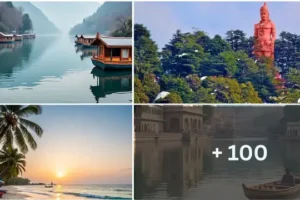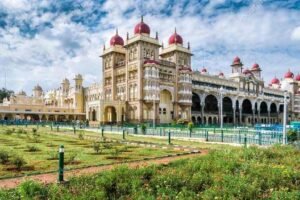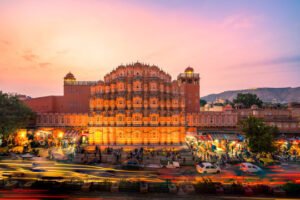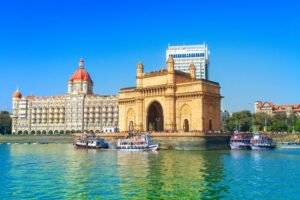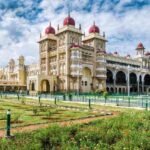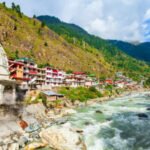1 Exploring the Murari Devi Temple, Breathtaking Divinity in Sundernagar, Mandi, Himachal Pradesh.
Introduction to Murari Devi Temple
The Murari Devi Temple is a Hindu temple located in Sundernagar, Mandi district, Himachal Pradesh, India. It is situated on top of a sacred hill named Murari Dhar, also known as Sikandara Ri Dhar (ancient name).
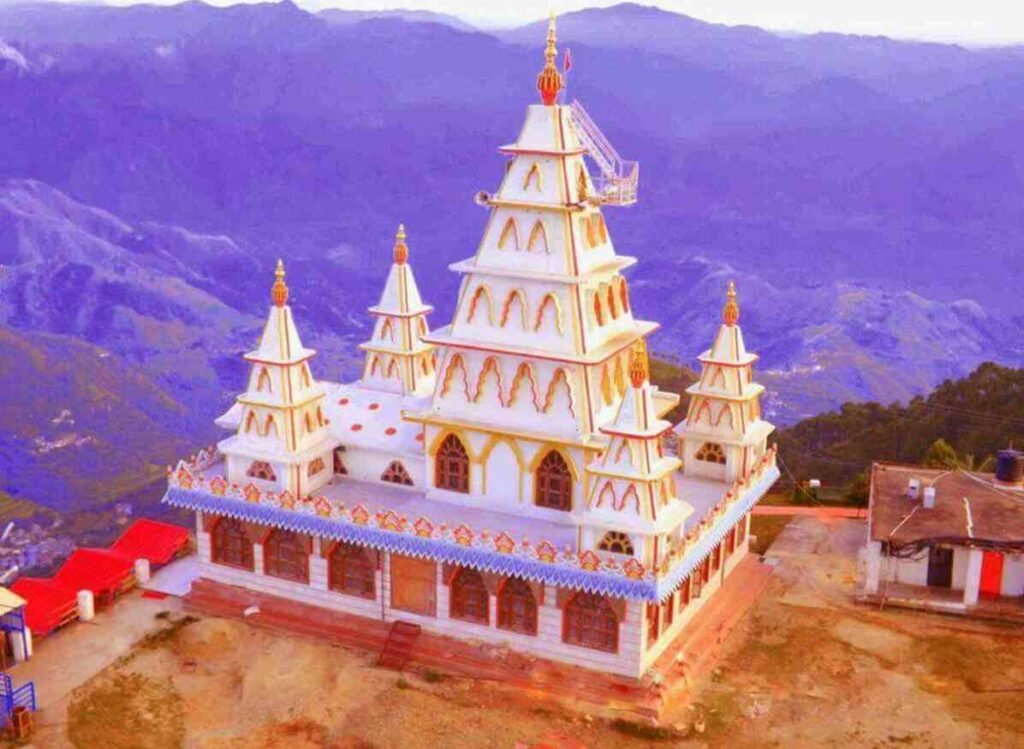
There are two main beliefs about the origin of the temple:
- One belief is that the temple was founded by the Pandavas during their exile (Agyatwas) in the Dwapar Yuga. It is said that the Devi appeared to them and asked them to build a temple on the hilltop where they would find two Pindas (religious icons).
- Another belief is that the name Murari Devi comes from Lord Vishnu, who is also known as Murari. The Devi emerged from him and established herself on the hill in the form of two Pindis, one representing Shantkaniya (peaceful) and the other representing Kalaratri (fierce).
Beyond its religious significance, Murari Devi Temple holds immense cultural value. It serves as a focal point for various traditional festivals and rituals, which are celebrated with great fervor and enthusiasm. These events not only reinforce the cultural fabric of the community but also attract visitors from different parts of the country, eager to partake in the temple’s vibrant festivities.
In essence, Murari Devi Temple is more than just a religious edifice; it is a symbol of the enduring faith and rich heritage of the people of Sundernagar. Its historical importance, coupled with the deep-seated veneration for Goddess Murari Devi, makes it a must-visit destination for anyone exploring the spiritual and cultural landscapes of Himachal Pradesh.
Historical Background of Temple
Murari Devi Temple in Sundernagar, steeped in antiquity, stands as a testament to the rich cultural and spiritual heritage of Sundernagar, Mandi in Himachal Pradesh. According to local legends and folklore, the temple is believed to have been built in honor of Devi Murari, a revered goddess known for her benevolence and protective powers. The origins of the temple trace back to ancient times, with various dynasties contributing to its evolution and prominence.
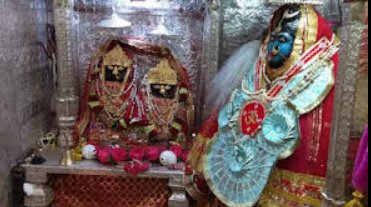
Archaeological findings around the temple complex reveal artifacts and inscriptions that date back to several centuries, indicating the temple’s sustained importance through various historical periods. These findings provide valuable insights into the socio-cultural and religious practices of the communities that revered Devi Murari. The temple’s strategic location atop a hill also suggests its historical role as a vantage point and a place of refuge during times of conflict.
The development of Murari Devi Temple is also closely linked to the patronage of local rulers and influential families. The rulers of the erstwhile princely state of Mandi played a pivotal role in the temple’s upkeep and expansion.
Their contributions, both in terms of resources and administrative support, ensured that the temple remained a vital spiritual center for the region. Additionally, the temple received patronage from various local chieftains and wealthy merchants, who donated generously for its maintenance and the organization of religious festivals.
Architectural Marvel
Murari Devi Temple is a testament to the architectural ingenuity that has been a hallmark of Himachal Pradesh’s rich cultural heritage. Nestled atop the Sundernagar hill, the temple stands as an epitome of traditional Himalayan architecture, seamlessly blending with the natural surroundings. The temple’s design is both functional and aesthetic, built to withstand the region’s climatic conditions while exuding an aura of spiritual serenity.

The structure of Murari Devi Temple is primarily composed of locally sourced stone and wood, materials that have been meticulously selected for their durability and aesthetic appeal. The stone walls are robust, providing a solid foundation that has stood the test of time. The wooden elements, intricately carved with motifs of deities, flora, and fauna, reflect the skilled craftsmanship of local artisans. These carvings aren’t just decorative; they narrate stories from Hindu mythology, adding a layer of spiritual significance to the architectural beauty.
One of the unique architectural features of Murari Devi Temple is its pagoda-style roof. This multi-tiered roof, adorned with wooden finials, not only enhances the temple’s visual appeal but also serves a practical purpose by efficiently shedding rainwater and snow. The roof’s overhangs provide shade and protection, creating a sheltered space for devotees and visitors.
Restoration efforts have played a crucial role in preserving the temple’s architectural integrity. Over the years, the temple has undergone several phases of renovation to maintain its structural stability and aesthetic charm.
The Deity and Rituals
Roshan Lal, the secretary of the temple committee, said that in 1992, people from about a dozen villages in this area formed a committee for the development of the temple. After this, the temple committee may have given wings to development at this place, but if the government works towards improving this temple, then Murari Dhar will emerge from the tourism point of view and the local people will also get immense employment opportunities.
A 3-day fair is organized every year from 25 to 27 May in the temple. Wrestling competition is the center of attraction in this, in which wrestlers from other states also participate. Let us tell you that there is a provision for accommodation of more than a thousand devotees in the temple inn. Devotee Aditya Gupta, who reached the temple, said that he has been coming to the temple for the last 20 years and his Kuldevi is also Mata Murari Devi. He said that any devotee who comes here does not return empty-handed.
Special ceremonies and festivals hold immense significance at Murari Devi Temple, drawing large crowds of worshippers. Navratri, celebrated with great fervor, spans nine nights and is dedicated to the worship of the goddess in her various forms. During this festival, the temple is adorned with vibrant decorations, and cultural programs, including traditional dances and music, are organized. Another significant festival is Diwali, the festival of lights, which sees the temple illuminated with countless lamps, symbolizing the triumph of light over darkness.
These rituals and festivals not only hold religious importance but also reinforce the cultural fabric of the local community. They provide an opportunity for communal gatherings, fostering a sense of unity and shared heritage. The practices observed at Murari Devi Temple reflect the deep-rooted traditions and spiritual fervor that characterize the religious life in Sundernagar, Mandi, and beyond.
Pilgrimage and Tourism
Murari Devi Temple, nestled in the scenic town of Sundernagar in Mandi, Himachal Pradesh, serves as a magnet for both devotees and tourists. The temple can be reached via multiple travel routes, ensuring accessibility from various parts of the country.
- For those traveling by air, the nearest airport is Bhuntar, approximately 82 kilometers away. From the airport, one can hire a taxi or take a bus to Sundernagar.
- The town is also well-connected by rail, with Mandi being the nearest railway station, which is about 24 kilometers from Sundernagar.
- Regular bus services and taxis are readily available from the railway station to the temple.
- All these hills are full of various kinds of trees, flowers and herbs. If you there in right reason, you would find multi-colored hills all around.
- Weather is pleasant most of the times. During summers, it can a bit hot because of direct sunlight. The good part is that 60% of the trek has tree shade.
- There are some water sources on the way, but it’s recommended to keep some water, juices and snacks with you.
Nearby accommodations cater to a range of preferences and budgets, from budget lodges to more comfortable hotels. Popular choices include the HPTDC-run Hotel Sukh Sagar and various guesthouses in Sundernagar, all offering convenient access to the temple. It is advisable to book accommodations in advance, especially during peak pilgrimage seasons and local festivals.
There are few beautiful villages around this trek and you can also encounter villagers with their cattle on the way. I love these roofs, which are made up of tiles cut out of a specific rock which is considered as one of the strongest rocks in Himalayan terrains. These black rocks are usually found in areas which get lot of snow. Over time, people are not having this kind of roofs in new houses. As you can notice in above photograph, the houses near the road have flat roof-tops which is common all over India now.
Scenic Surroundings and Breathtaking Views
The landscape around Murari Devi Temple is adorned with dense forests, comprising a rich variety of flora. Deodar, pine, and oak trees dominate the vegetation, providing a refreshing canopy of greenery. During the spring and summer months, the area is vibrant with blooming wildflowers, adding splashes of color to the verdant surroundings. The crisp, clean air and the gentle rustling of leaves enhance the sense of tranquility and connection with nature.
The fauna in the region is equally captivating. Visitors might catch glimpses of various bird species, including Himalayan monals, pheasants, and eagles soaring high above. The more observant might also encounter small mammals like the Himalayan musk deer or the elusive snow leopard, making the journey to the temple an exciting prospect for wildlife enthusiasts.
Nearby attractions further enrich the experience of visiting Murari Devi Temple. The Sundernagar Lake, located just a short drive away, is a popular spot for picnics and boating. Its calm waters and surrounding gardens offer a serene retreat. Additionally, the Himachal Pradesh Hydel Park, with its expansive greenery and recreational facilities, is another nearby highlight that visitors often explore.
Viewpoints around the temple provide awe-inspiring views of the Dhauladhar and Pir Panjal mountain ranges, especially during sunrise and sunset. These natural vantage points offer an unparalleled opportunity to witness the majestic beauty of the Himalayas, making the visit to Murari Devi Temple an unforgettable experience for all who venture here.
Best Time to Visit Murari Devi Temple in Sundernagar
The best time to visit the temple is during the summer months, from April to June, when the weather is pleasant and conducive for travel. However, if you wish to experience the temple’s vibrant festivals, visiting during the Navratri season in October can be particularly rewarding.
How to Reach Murari Devi Temple in Sundernagar
Murari Devi Temple, a revered spiritual site located in Sundernagar, Mandi, Himachal Pradesh, is accessible through various modes of transportation:
By Air: The nearest airport is Bhuntar Airport in Kullu, approximately 82km away from the temple. Bhuntar Airport operates domestic flights connecting major Indian cities. Alternatively, travelers can also consider Chandigarh International Airport, which is around 180km from the temple and offers a wider range of flight options.
By Train: The closest railway station is in Joginder Nagar, located about 80km from Sundernagar. Joginder Nagar is connected to several prominent cities via an extensive rail network. From the railway station, travelers can hire taxis or use local bus services to reach Sundernagar. Another viable option is the Chandigarh Railway Station, around 160km away, providing comprehensive train connectivity.
By Bus: Bus services are another convenient way to reach Murari Devi Temple. Regular bus services operate from major cities in Himachal Pradesh and neighboring states to Sundernagar. Himachal Road Transport Corporation (HRTC) runs both ordinary and deluxe buses, ensuring a comfortable journey. Once in Sundernagar, visitors can hire a taxi or take a local bus to the base point of the temple
The Trek: The temple is situated atop a hill offering an easy trek. The trek is approximately 2 kilometers long and offers a picturesque view of the surrounding valleys and mountains. For those who prefer not to trek, local taxis and jeep services are readily available to transport visitors to the temple’s base point. The road leading to the temple is well-maintained, ensuring a smooth journey.
Murari Devi Temple Guidelines
Visitors are advised to dress modestly and respectfully when visiting the temple, as it is a place of religious significance. Traditional Indian attire such as sarees or salwar kameez for women and kurta pajamas for men are appropriate. Comfortable footwear is also recommended, as you may need to walk uphill or navigate uneven paths to reach the temple.
It is important to observe cultural and religious etiquette during your visit. Removing shoes before entering the temple premises is customary, and maintaining a quiet and respectful demeanor is appreciated. Photography may be restricted in certain areas, so it is advisable to seek permission before capturing images.
By adhering to these guidelines and being mindful of local customs, visitors can ensure a respectful and enjoyable experience at the Murari Devi Temple. Whether you are there for spiritual solace or to immerse yourself in the region’s rich cultural heritage, a well-planned trip will undoubtedly enhance your visit.
What is the height of Murari Devi Temple?
Murari devi temple is situated in sundernagar Mandi Himachal Pradesh at the altitude of 2200m.
Where is Murari Devi Temple?
The Murari Devi Temple is a Hindu temple located in Sundernagar, Mandi district, Himachal Pradesh, India. It is situated on top of a sacred hill named Murari Dhar, also known as Sikandara Ri Dhar (ancient name).
How long is Murari Devi Trek?
The trek is approximately 2 kilometers long and offers a picturesque view of the surrounding valleys and mountains.
How far is Murari Devi Temple from Sundernagar?
The temple is about 1.2 km from Sundernagar at the base point of trek.
How far is Murari Devi Temple from Jahu?
The temple is almost 36.3km from Jahu.
